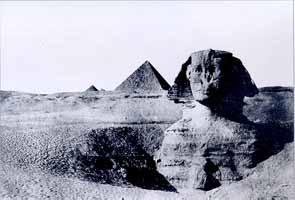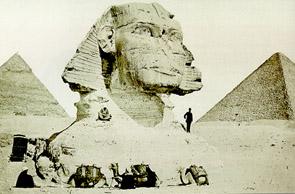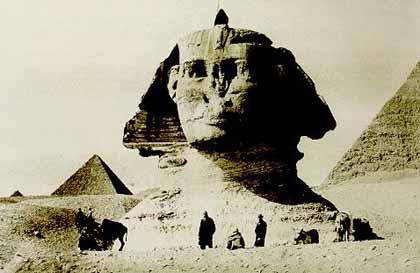|
Giza
Sphinx in Pictures
PAGE 2
|
At
the front, sand came up to the shoulders and nothing of the
beast was visible (until the engineers dug down, possibly just
uncovering the Tuthmosis IV stela before abandoning work); but
the whole ridge of the back was visible, and at the hindquarters
the sands fell away to reveal something of the rump of the Sphinx.
What was entirely new in depictions of the Sphinx was that the
whole setting of the Giza Plateau was accurately recorded, with
correct perspective in the placing and rendering of the pyramids
behind it.

The
Sphinx by Maxime Du Camp, 1849.
From the Photographic Collection
of the New York Public Library. |
No
doubt the artists who made their sketches on site could avail
themselves of the most up-to-date cameras and other drawing
aids. When Howard Vyse published his account of Operations
carried on at the Pyramids of Giza in three volumes in the
early 1840s, the first photograph of the Sphinx had not yet
been taken. Howard Vyse's picture of the Sphinx under excavation
by Caviglia shows the sand dune around the Sphinx quite parlously
opened up in front of the beast and round the left shoulder,
revealing the front paws and the chapel between the forelegs.
The Dream Stela is well depicted, with something of its graphic
design conveyed, while the jumbled masonry behind it and the
column of blocks suggest evidence of the original presence
of a statue and the support plate of the beard. But the distance
from the enclosure floor to the chin is vastly exaggerated
and the disproportion of head and body quite marked. The first
photographs of the Sphinx were taken in 1849 by Maxime Du
Camp and published in 1852 in one of the earliest books to
be extensively illustrated with real photographic prints made
from negatives - in this case calotype paper negatives.

The
Sphinx at the extreme right of the photography
by Hammerschmidt, 1858. |
Du
Camp travelled with Flaubert a year or two before Madame Bovary,
and both writers were bowled over by the Sphinx. 'No drawing
I have seen conveys a proper idea of it,' wrote Flaubert,
'the best thing is an excellent photograph that Max took.'
In the better of Du Camp's two photographs, the benefits of
the first modern sand-clearances are still to be seen, but
the Dream Stela has apparently gone under again. In the background
is the pyramid of Menkaure with one of its subsidiaries. Khafre's
pyramid is out of frame to the right, and his causeway is
entirely invisible under the sands. The featureless and too-light
sky has resulted from the colour-blind quality of the early
photographic processes.
|
 |

The
Sphinx by Zangaki, before 1880 |
Thousands
of photographs were taken of the Sphinx, by both amateurs
and professionals, as the age of photography got under way
and the business of photography became simpler and more reliable
after about 1880. Before that, there was a ready market for
prints of Egyptian antiquities sold by professional photographers
like Beato, Bonfils, Hammerschmidt, Lekegian, Sebah and Zangaki.
Their photographs mainly chart the swamping and clearance
of the sand about the monument.
A striking picture by Hammerschmidt, in which foreground trees
grow out of half-submerged ruins on the slope of the Giza
Plateau, shows the Sphinx head peeping out of the sand below
the Great Pyramid of Khufu: it was taken in 1858, at about
the time that Mariette was excavating at the Sphinx. Despite
Mariette's work, the sands soon invaded the breast area of
the monument again and photographs from the 1860s show no
front paws, no chapel, no stela - all this was once more buried
under a sand drift.

The
Sphinx by unknown nineteenth-century photographer |
One
of Zangaki's photographs shows picturesque camels at the Sphinx's
breast, sitting on a sandbank that hides the forelegs, chapel
and stela below, with the photographer's travelling darkroom
drawn up alongside the upper right flank of the monument.
A picture by Sebah, taken from the north-east, with Menkaure's
pyramid in the background, shows particularly clearly the
great fissure at the hindquarters and the severe gouge in
the left-hand side of the top of the head. Another, by an
unknown photographer, also shows this deep (and inadvertently
rather characterful) cut in the top of the head, with a sentinel
figure sitting above the uraeus: the pyramid to the right
of the picture is that of Khafre. A second photograph taken
by Sebah shows the Sphinx's head with the Khufu pyramid behind
it and the valley temple of Khafre in the foreground, first
excavated by Mariette: the plain granite pillars and lintels
of the temple interior are clearly seen, together with some
of the massive (and highly eroded) limestone blocks of the
core construction of this building. Though cleared by Mariette,
sand is seen in this photograph to be reinvading the interior.
A picture by Fiorillo of 1882 shows members of the British
Army disporting themselves on and around the Sphinx in the
year when the British under Sir Garnet Wolseley asserted Britain's
imperial power in Egypt.
|